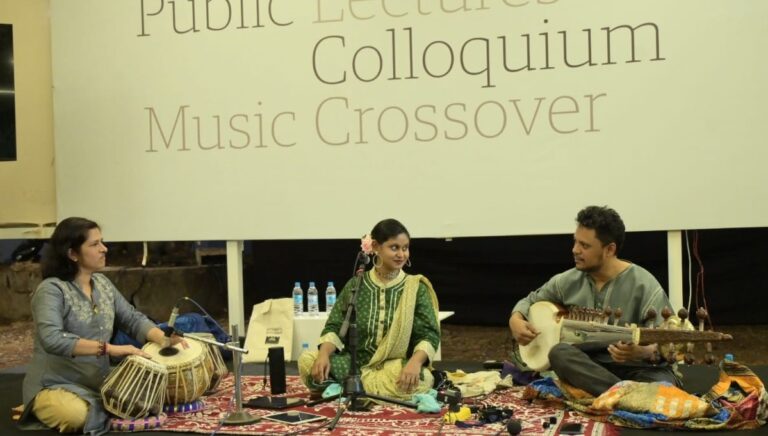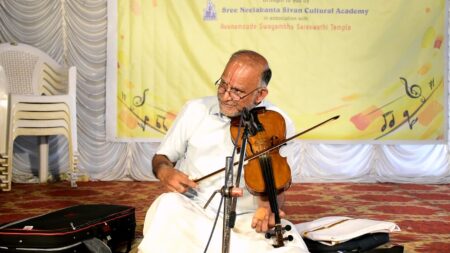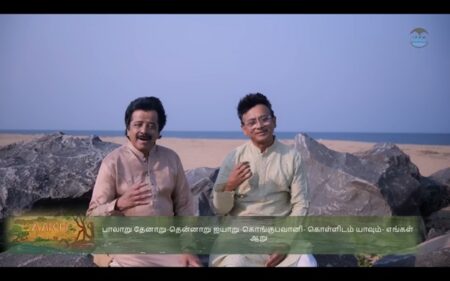Hindustani music concert by Moumita Mitra, Sayak Baruva and Retnasree Iyer at the ITFoK venue enlivened the audience.
Dusk was settling in the Sangeetha Nataka Akademi complex and illumination was gradually brightening Akademi compound. The theatre halls were slowly being filled by theatre fans. Amidst the din, one could hear the sound of Sarod wafting in the air from the make-shift auditorium viz. Artist Sujathan Scenic Gallery situated at a corner of the complex. The music fans among the crowd rushed to the Gallery to see Sayak Baruva plucking out alluring strains of rag Basant Pancham.
‘Music Cross Over’, the only programme of classical music in the International Theatre Festival of Kerala (ITFoK) showcased a Hindustani ensemble of ‘Bandish Aur Gat Jugalbandhi’ presented by Moumita Mitra (vocal), Sayak Baruva (Sarod) and Retnasree Iyer (Tabla).
The opening words of Baruva explained the scheme of the show. His recital would be followed by a vocal one by Maoumita and finally a jugalbandhi of the two, all accompanied by Retnasree, the only female tabala artist in South India and the only female awardee of the Akademi.
Basant Pancham is played without any restrictions of time during the Saraswathy puja only for three days. The alaap was quite extensive and in the typical style of the instrument. Alap and jhala was followed by teentaal gat in sixteen cycle in Madhya laya. This could bring out the intricacies of the raga effectively. Drut teentaal was executed in sixteen beat cycle. The fast tempo was inspiring and the meends were especially noteworthy. Also this part could exhibit the wizardry of Baruva.
Charming style
Moumita has a soft and pleasing voice and she appeared in a meditative mood as she opened the alap of Puriya Kalyan, an evening raga. The composition, ‘Moree Ghar Ajaa’, a payer to Krishna, was in the traditional tempo. The style of rendition evoked the musician’s bhakti to Krishna as the lines explained that “my heart and soul are dedicated to you, Krishna”.
Her second choice in the raga in fast tempo of teentaal was a prayer to Rama. It conveyed that chanting of Rama’s name brought inner peace.
Kaafi was the raga for the jugalbandhi between vocal and sarod. Also an evening raga, the vocal style and that of the instrument embraced subtle differences. And Raetnasree managed to adjust her playing accordingly. Interestingly, there was variety as the first composition was a Tarana in Rupak taal of seven beats and the second was a tappa in Adhya, a variant of teentaal in sixteen beats. Maoumita explained that tappa had its origin from the camel drivers in Punjab. Enthralling was the performance of Retnasree throughout.
While Moumita belonged to Kirana Gharana, Baruva was a Maihar Gharana musician. Short explanation before the recital of each number by them appeared a didactic attempt. That the audience seemed to have enjoyed the recital to the hilt was evident from the way they mobbed by the musicians post-recital.
They were presented with memento by Pushpavathy, vice-chairperson of the Akademi who is also a professional musician.




